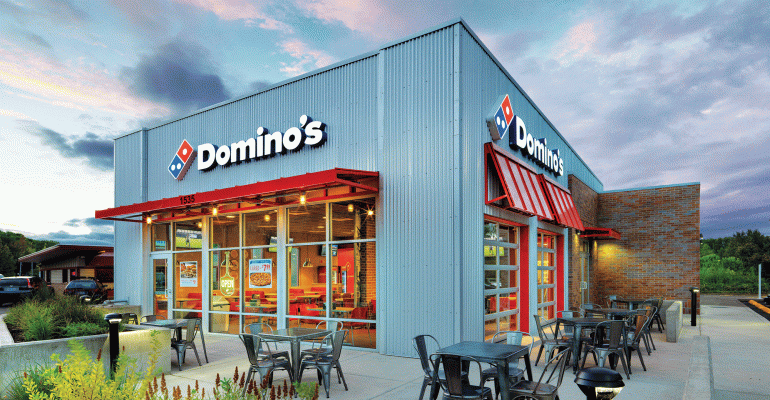Domino’s Pizza Inc.’s sales surge over the past six-plus years has taken the chain to the cusp of something not long ago considered a long shot: overtaking rival Pizza Hut as the largest pizza chain in the country.
In fact, that might have already happened, as CEO Patrick Doyle suggested on the company’s third-quarter earnings call Thursday.
“The quarter can be best described as us continuing to execute our established approach, and simply do what we do best,” Doyle said. He cited its alignment with franchisees and its brand investments, “which, we believe, has led to us selling more pizza in the U.S., and around the world, during the third quarter than any other pizza brand.”
Domino’s growth in recent years has easily bested not just the pizza sector but the restaurant industry in general — publicly traded restaurant chains on average have generated negative same-store sales in the first two quarters, while Domino’s this year has averaged same-store sales growth of 9.4 percent.
On Thursday, the company reported 8.4 percent same-store sales growth in the period ended Sept. 10, the 26th straight quarter of growth. Domino’s quarterly same-store sales growth averaged 7.5 percent during those 6.5 years.
Domino’s was the 10th largest restaurant chain in the U.S. last year, based on NRN Top 100 data, right behind No. 9 Pizza Hut — which for years has held the mantle as the country’s largest pizza purveyor.
Based on current growth rates, Domino’s is well on its way toward overtaking Pizza Hut for the top spot this year. Going into the year, Domino’s needed to increase system sales by 8 percent to take the top spot if it rival stood still — and Pizza Hut’s system sales fell 5 percent in the first half of the year, according to SEC filings.
Just five years earlier, Pizza Hut generated 60 percent more system sales than did Domino’s.
Domino’s success in recent years has come as the chain invested in customer-facing technology — customers can order through their app, the website, Amazon’s Echo devices and even their television, watch or a car — while convincing operators to remodel stores to bolster in-store pickup business.
The chain has also thrived since its introduction of a loyalty program in 2015.
“Our strategy remains simple: We have a single-minded focus on improving every aspect of the experience for customers,” Doyle said. “We’re funding investments and skipping the flavor-of-the-month activity so common in the industry.”
What, exactly, is driving that performance? Doyle said he knows — the company has extensive customer data capabilities — but won’t say.
“We understand pretty clearly what is driving our business and how each of the components are feeding into that,” he said. “But we are not going to share that.”
Domino’s success, however, has been well documented, and investors have grown increasingly confident in its ability to generate extraordinary same-store sales results. Thursday’s report of an 8.4-percent increase, in fact, was considered a disappointment.
As of early afternoon, Domino’s stock had fallen more than 4 percent, even though analysts indicated the company’s same-store sales outperformed their expectations.
Mark Kalinowski, analyst with Instinet, said that sell-side analysts expected same-store sales of 6.5 percent, but analysts working with institutional investors were more bullish. He also said that some investors are selling the company’s stock on the good news.
Indeed, the 8.4 percent was Domino’s lowest since the first quarter of last year, and is below the company’s 10.8-percent average since the fourth quarter of 2014. Still, Kalinowski expects that Domino’s results will prove to be the industry’s best during the period.
On the earnings call, Doyle said that none of the chain’s primary chain rivals, including Papa John’s International Inc., Yum! Brands’ Pizza Hut and the privately held Little Caesars, have had much impact on the chain’s performance.
“Short-term moves of pricing from competitors generally don’t have that much effect because the category is so fragmented,” Doyle said. “Our largest competitor in the U.S. in total is all of the locals and the mom-and-pops and the regional chains. Their pricing in the aggregate doesn’t move that much, because it’s a lot of individual decisions.”
Contact Jonathan Maze at [email protected]
Follow him on Twitter at @jonathanmaze





